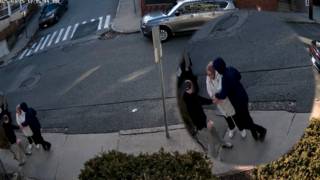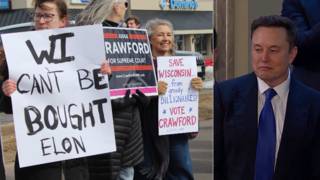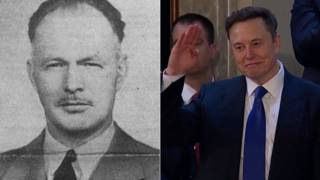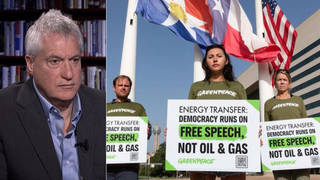
Topics
Guests
- Marcus Eriksenenvironmental scientist and research director for the 5 Gyres Institute, studying the global distribution and impact of plastic. He is the author of Junk Raft: An Ocean Voyage and a Rising Tide of Activism to Fight Plastic Pollution and My River Home: A Journey from the Gulf War to the Gulf of Mexico.
- Priscilla VillaSouth Texas organizer at Earthworks, part of the #BreakFreeFromPlastics movement.
This Sunday more than a billion people will celebrate Earth Day. This year’s theme: ending plastic pollution by Earth Day 2020. Of the nearly 300 million tons of plastic sold each year, about 90 percent ends up in landfills, in the oceans—and in our bodies. Part of the focus will be microplastics, those small bits of plastic that are seemingly everywhere. We speak to Marcus Eriksen of the 5 Gyres Institute, who has led 20 expeditions around the world to research plastic marine pollution, and Priscilla Villa of the #BreakFreeFromPlastics movement.
Transcript
AMY GOODMAN: This Sunday more than a billion people will celebrate Earth Day. This year’s theme: ending plastic pollution by Earth Day 2020. Of the nearly 300 million tons of plastic sold each year, about 90 percent ends up in landfills, in the oceans—and in our bodies.
Well, our next guest is considered a leading expert on microplastics, those small bits of plastic that are seemingly everywhere. Marcus Eriksen has led 20 expeditions around the world to research plastic marine pollution. In 2008, he embarked on an 88-day journey from California to Hawaii on a raft built from 15,000 plastic bottles and recycled junk. Dr. Eriksen documented the journey in his book Junk Raft: An Ocean Voyage and a Rising Tide of Activism to Fight Plastic Pollution and on video.
MARCUS ERIKSEN: What you see here is a bunch of zooplankton and plastic. It’s the same-size pieces we find inside the stomachs of these fish, the lanternfish, the myctophids. Now, you’re here in the middle of nowhere, and you still find this trash. The human footprint is everywhere, everywhere you go. On top of mountains, the bottom of the ocean, evidence of us.
AMY GOODMAN: Five years earlier, Dr. Eriksen had rafted the Mississippi River and wrote about his experience as a marine in the 1991 Gulf War in the book My River Home. Eriksen’s work on discovering plastic microbeads in the Great Lakes led to the federal Microbead-Free Waters Act of 2015.
Well, Marcus Eriksen joins us now from Los Angeles. Welcome to Democracy Now! As we lead into Earth Day, first explain what microplastics are. Lay out the challenge to the world.
MARCUS ERIKSEN: So, microplastics are small, broken-down fragments from larger items. Those are your secondary microplastics, formed by things falling apart. For example, in the oceans, we often find bottles. Here’s one bottle. You can see the edge is all bitten off. So, animals are tearing larger plastics into smaller bits. The sun breaks them down, makes them brittle. Waves then crush it. So what we’re finding is, a lot of the trash that leaves their land, out to sea via our rivers, are beginning to form bigger items into smaller items that microplastic forms near shore. By the time I get to the middle of the ocean, I’m hardly finding any big items—a few fishing buoys in nets—but a smog a small particles everywhere.
AMY GOODMAN: So, explain these microplastic beads everywhere.
MARCUS ERIKSEN: Well, the microbeads, that was a primary microplastic. They were designed to be small. And those are the ones that we saw in our facial scrubs and toothpaste. But Obama signed the Microbead-Free Waters Act in 2015. So, microbeads, we’ve been able to do away with, through some great campaigning. But the microplastics are just everything that breaks down into small particles. And we have found them in the middle of the oceans, all the five subtropical gyres, Antarctica, the Arctic. We have found them frozen in sea ice and the deep floor—deep sea floor sediments. So the distribution has gone global of these small bits, like as big as a grain of rice or smaller. They’re everywhere.
AMY GOODMAN: What is the impact of plastics on human beings, Marcus?
MARCUS ERIKSEN: On us, well, you can say it’s twofold. One is the issue of plastics as waste, that contaminates other living things, including fish, that the world depends on. You know, I think one-sixth of the planet gets their protein from fish. And we’re seeing this explosion, these clouds, this smog of microplastics, impacting the food chain. And the toxins that sticks to plastics are also polluting organisms in that food chain. But as a pre-consumer product, which you might grab off the shelf, we’re still finding some synthetic chemistry in those, like bisphenol A and phthalates, that you don’t want in your body or the bodies of your children. They’re endocrine disruptors. They’re carcinogenic. So there is the pre-consumer and the post-consumer impacts of throwaway plastics on human health.
AMY GOODMAN: I want to go to another clip from your documentary that you produced on the junk raft project.
MARCUS ERIKSEN: Two-fifths of the plastic made in the world come from the United States. There’s a very huge corporate interest in maintaining production of plastics. This is what the ocean looks like 2,000 miles from the California coast. Now, this is roughly three football fields netted and consolidated into one jar. But keep in mind there are 9 million football fields of area in the North Pacific. And it all looks like this. So we can’t mine this area with giant nets to clean this problem. The only fix is a cultural fix, by changing our use of plastics.
We decided, while we’re at sea, to get the nation’s attention by building a boat out of the same plastic trash we consume every day. So we built a boat out of 15,000 plastic bottles, old fishing nets to hold those bottles together, and 20 sailboat masts, an airplane wing to make a flat deck. We’ve had three high schools provide these bottles, help us make pontoons. It very quickly became a project much bigger than ourselves.
AMY GOODMAN: I mean, there are so many directions to go in, but let me ask you about the efforts to get rid of BPA in plastic bottles and microbeads in beauty products. How pervasive is this?
MARCUS ERIKSEN: Well, I would step back and talk about the process. So, Frederick vom Saal is a colleague of mine who’s been studying BPA in mice all his life. And he was finding that, you know, the BPA was actually leaching out of the containers where he had the mice living in. So he found that BPA was there. It’s all around us. In adding machine tape, when you get a receipt, if it’s wet, you might see a white residue on your hands. That’s BPA. The plastic lining in metal cans, the reason why your can of beans doesn’t rust from the inside is a thin layer of BPA. And in many children’s toys, you find phthalates.
And talking with Dr. vom Saal, his science work, it was such a challenge to get that into the hands of producers and say, “OK, your science says it’s a problem. Let’s stop.” Instead, it was a long, drawn-out fight to get phthalates, BPA out of water bottles, out of children’s toys. And the fight continues to get them out of other areas where BPA gives us some exposure. So I think, you know, that was a challenge.
With microbeads, the same thing. But I can tell you, the science work that I did on microbeads in the Great Lakes, with Sam Mason, a colleague of mine, that was just the start. There was a huge coalition, organized by many colleagues and different organizations that do advocacy work, working together with the same kind of—with the same science foundation. The information was there. We had the—we had the videos and the photography to share of animal impacts by microbeads. Then we had sample legislation, and we had some champions in the White House. And within, you know, a couple years after publication, this massive coalition brought the bill to Obama’s desk, and he signed it. And again, it’s this long, drawn-out fight for things that are obviously wrong and need to be fixed.
AMY GOODMAN: From Seattle to Malibu, cities have banned certain plastics. The U.K. and Kenya, for example, have announced plans to ban some plastics countrywide. Talk about the efforts around the country and the world, and states also circumventing cities, trying to prevent them from banning plastics.
MARCUS ERIKSEN: Well, you know, it’s really—it’s fabulous to see there’s this movement growing around the world, the Break Free from Plastics movement. It established about a couple years ago. We now have over 1,060 organizations that have come under this values statement about single-use plastics. And they have no place in society because of the negative externalities. When I say “single-use,” I mean it’s the plastic bags, the bottles, the cup lids, the straws, the little plastic stir sticks—these things that you use once and then throw away, but using a material designed to last forever. That is creating mountains of waste around the world. And you’re seeing communities sort of rise up and say, “We’re done with this, this linear system of companies making stuff, selling it and washing their hands clean of any responsibility for the stuff where it resides.” When I go from island to island, you know, around the world on our sailing voyages, you see these mountainous landfills, sometimes next to the sea, and islands saying, “We don’t know what to do with all of this stuff.”
Now, I can talk about one of the challenges here in the United States. It’s a concept called preemption. So, without preemption, for example, in states like California and a few across the country, grassroots movements, in city by city, can say, “We don’t want plastic bags. We don’t want plastic straws. The pollution is too burdensome. And we, as taxpayers, are tired of paying for cleanup.” So, communities and grassroots movements are working, and they’re succeeding, town by town. What preemption does, it’s been an industry-sponsored bill that goes from state to state and tells the states to tell their cities that “You can’t do that anymore. Any decision to ban bags has to come from state-level policy.” It makes it illegal for grassroots movements in small towns to ban these single-use, throwaway, polluting products.
AMY GOODMAN: I want to bring in another guest. You mentioned the Break Free from Plastics coalition. Let’s go to Houston, the—what some call the Petro Metro, the petrochemical capital of the United States. Texas alone produces nearly three-quarters of the country’s supply of one of the basic chemical building blocks for making plastics—ethylene, much of which is derived from oil extracted through fracking. So, we’re joined by Priscilla Villa, the South Texas organizer for Earthworks. She recently helped host the first U.S. meeting of the Break Free from Plastics movement, that seeks to raise awareness about the link between plastics in our water and oceans and pollution from oil and gas extraction and refining related to plastics.
Priscilla, welcome to Democracy Now! Talk about what you’re doing and the whole cycle, from oil fracking to plastics.
PRISCILLA VILLA: Hi, good morning. Thank you so much for having me.
So, the meeting that we had in Houston was the first U.S.-based Break Free from Plastics meeting that we hosted alongside with t.e.j.a.s. One of the main reasons that we had this meeting was so that organizations who are working across the life cycle of plastics could really get together and talk about how we can support our work along this life cycle of plastics.
So the work that Earthworks specifically does, we focus on extraction and the issues that go along with fracking. So, when you’re talking about a fracked well and/or fracking for oil and gas, one of the byproducts is a natural gas liquid called ethane. In order to—so, ethane, in and of itself, is not necessarily useful. It’s been considered a waste product. But in order to make it something, to turn it into plastics, you first have to crack it. So there are all these facilities along the Gulf and Pennsylvania that are called crackers. And so, these facilities crack ethane into ethylene. And then, ethylene—you have these ethylene pellets that then get exported out and eventually turn into plastics. And those are the main building blocks, as you said, of plastics.
AMY GOODMAN: And Texas aiming to be the plastics capital, or Houston, of the country?
PRISCILLA VILLA: Well, the oil and gas industry is investing around $86 billion in over 280 infrastructure—280 facilities that would be turning ethane or ethylene into plastics. And a lot of the build-out is really being focused in the Gulf South, so in Texas—Portland, Texas, for example, where Exxon is proposing to build the world’s largest cracker facility. There are folks out there who are opposing that particular facility. And there’s even more build-out for Houston, for example.
And one of the big issues there is that, considering the impacts and everything that came along with Hurricane Harvey, it’s a vulnerable place to be building this kind of infrastructure, because you had incidents like the explosion at the Arkema plant, for example, that put a lot of people at risk. And not to mention the ongoing emissions that come from a lot of these facilities in the Gulf also contribute to bad air quality and bad health. So, more of these facilities mean more people are put at risk. So when we talk about plastics and pollution, we also need to be talking about the pollution that is tied to the production piece, in the very first stage of plastics.
AMY GOODMAN: Well, we’re going to have to leave it there now, but of course we’ll continue to cover this. Again, Sunday is Earth Day, celebrated around the world. The theme now: end plastic pollution. Priscilla Villa, joining us from Houston, part of the Break Free from Plastics movement. And Marcus Eriksen, co-founder of 5 Gyres Institute.
That does it for our show. A fond farewell to Camille May Baker. We wish you the very best in what will clearly be a brilliant career.
Tonight, I’ll be in Lincoln, Nebraska, at the Rococo Theatre, 8 p.m. Hope to see you there, celebrating KZUM’s 40th anniversary. Saturday night, Democracy Now!'s Juan González will be speaking at Lehigh University in Bethlehem, Pennsylvania. And on Tuesday at noon, I'll be speaking in Teaneck, New Jersey, at the Puffin Cultural Forum. All welcome.
Democracy Now! accepting applications for our paid, year-long social media fellowship. Check out democracynow.org.












Media Options